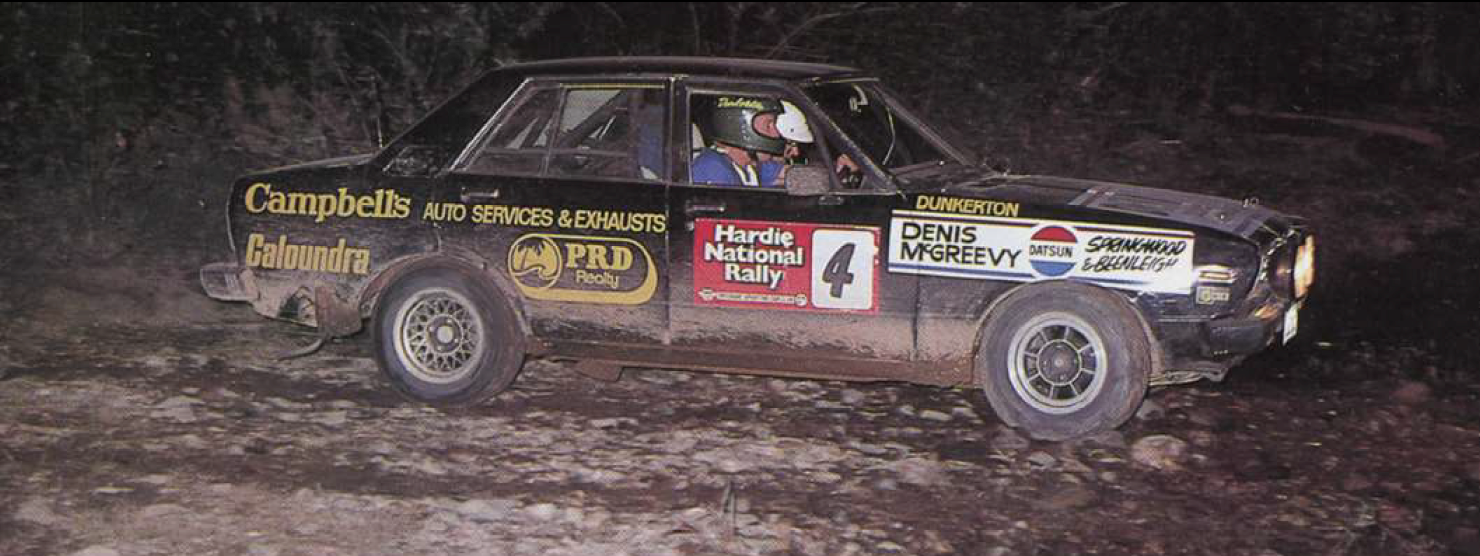

1983 CAMS AUSTRALIAN RALLY CHAMPIONSHIP
About the kindest thing that can be said of the 1983 Australian Rally Championship is that it was not as bad as was expected! The truncated four-round series began slowly but the final two events were entertaining and competitive. With the previous year’s stars, Greg Carr and Geoff Portman, out of the way it was left to the even-matched ‘’secondstringers’’ to turn on the action – and this is just what they did.
Nevertheless, there were few signs in 1983 that there was any real recovery in the sport. The downward spiral which began with the withdrawal of the factory teams at the end of the 1970s continued largely unabated and the championship fields were further weakened by the absence of Ed Mulligan, Tony Masling and Doug Thompson.
The only light at the end of the tunnel was Group A, introduced by CAMS into the sport at the beginning of 1982 when racing went this way. Group A was for near standard cars and it produced arguments, protests, controversy, and precious little good competition but it was still the pointer to the future. It was the only way that factory teams were ever going to be enticed back into the sport to introduce new models and wide spread publicity and promotion.
Ross Dunkerton was the eventual championship winner and it took him three different cars and two different navigators to do so. The points system was equal for CAMS Group G and Group A categories – the best placed Group G crew were awarded 20 points and the best placed Group A crew also received 20 points – even if the latter finished in 15th outright place.
Dunkerton was equal third in Perth (Datsun 1600 Group G), won in Queensland (Datsun Stanza Group G), did not finish in New South Wales (entered Stanza Group G) then came 15th in the Victorian round in a Group A Holden Commodore – thus earning 20 points which gave him a total of 56 ½.
Peter Johnson, Group A Mazda RX7 was second with 55 points, finishing each event well behind many Group G cars but getting high points for finishing high amongst the Group A cars.
David Officer/Kate Hobson (Group G Mitsubishi Galant) were the best placed Group G car but were third in the championship with 54 ½ points. They were the most consistent throughout the year with an equal third in the first round, and then third places in the other three rounds.
As Dunkerton was reported to have said … ”I sleazed it in”. Geoff Jones, who ran the first three events with Johnson, changed to navigate Dunkerton in the last event and was the champion navigator, with Kate Hobson second.
It was a somewhat complicated year in determining the championship points!!
The only crew to win more than one round was Ian Hill/Phil Bonser (Ford Escort RS 1800). Hugh Bell (Mazda-engined Datsun 1600 – ‘Dazda’) led each of the three rounds he contested but fell by the wayside in each of them, but he was far and away the most entertaining driver in the country.
Geoff Portman ran out of time preparing his Nissan Bluebird Turbo and had to miss the first two rounds and was an early retirement in the other two. Greg Carr started the year with a win in Perth but then things went wrong. His first rollover in a 13-year career put him out in Queensland, and in the last two rounds he was leading comfortably but suffered terminal problems with the Fiat 131 Abarth.
Colin Bond and George Fury made a couple of appearances with no results, Wayne Bell lacked a competitive car and picked up a sixth in Queensland. Ron Marks and Bob Watson ran Renault R5 turbos, but with any success.
The championship events themselves were much the same as the previous year, apart from the lack of an event in South Australia.
A conclusion at the end of 1983 was that the outdated dinosaurs that were running in Group G had lingered too long in the sport and taken Australian rallying off down a desolate and remote path and must be replaced by cars which have credibility with the public, manufacturers and the international rally community. It generally was felt that when this happened the downward spiral which afflicts the sport should be halted and eventually reversed.
1983 CAMS AUSTRALIAN RALLY CHAMPIONSHIP
This document includes the summary, details of four rounds of the 1983 ARC and is 7 pages in length.
View the document below – use mouse, scroll bar or page controls to move through the document.
Previous
1982 Australian Rally Championship
Up
ARC 1968-1988 contents page
Next
1984 Australian Rally Championship